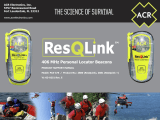
THE SCIENCE OF SURVIVAL
ON - Transmitting 406 MHz WITH GPS
ON - Transmitting 406 MHz Only
Registration is Mandatory
This EPIRB must be promptly registered with the appropriate National Authority.
To Register:
Download EPIRB Registration Form or Complete
Registration Online by going to:
www.ACRARTEX.com/Support/Registrations
1. Select Your Country
2. Follow the online link to complete your
registration online (Preferred Method) or
Download the registration form and Mail or
Fax to your national authority.
The beacon may be self-tested as is warranted, once a month or up to a recommended maximum of 120
times in the ten (10) year life of the battery. ACR recommends that a self-test be performed on a monthly
basis. The self-test can be done inside or outside a building or vessel.
A self-test is initiated by pressing the self-test button for one (1) second, until a brief green LED flashes, and
then releasing the button. You will then see three (3) additional green LED flashes (representing separate
successful individual tests performed as part of the self-test) followed by a long green LED flash and a long
beep indicating a successful test. If any of the individual tests fail during the self-test, there will be a red
flash and beep associated with each failed test and there will then be four beeps, a long red LED flash, and a
strobe at the end of the self-test. Self-test will discontinue at that point and the beacon must be sent in for
repair.
Category I beacons are designed to be automatically deployed and activated in the
event of a vessel sinking. The beacon may also be manually taken out of the category
I bracket and activated manually or immersed in water to activate automatically.
Category II beacons are designed to be manually deployed from the category II
bracket and then activated manually or placed in the water to activate automatically.
Category I and II beacons can also be manually activated while still in their brackets.
Manual activation occurs by doing the following:
ACR Electronics, Inc.
5757 Ravenswood Road, Fort Lauderdale, FL 33312, U.S.A.
For an expanded manual visit: www.ACRARTEX.com
ACR Electronics, Inc.
5757 Ravenswood Road, Fort Lauderdale, FL 33312, U.S.A.
For an expanded manual visit: www.ACRARTEX.com
Extended GPS Test LED Sequence
Activation LED and Strobe Sequence
WARNING: This transmitter is authorized for use
only during situations of grave and imminent danger.
Deliberate misuse may incur a severe penalty.
ACTIVATION - EMERGENCY USE ONLY
EXTENDED GPS TEST
REGISTERING YOUR BEACON - MANDATORY
All 406 MHz beacons transmit a Unique Identifier Number (UIN) when activated. This UIN is programmed
into the beacon based on the country in which the beacon is registered, thus authorities are able to
determine which country’s database will have your registration information. SAR forces will have
information as to who you are as the owner of the beacon, the name and type of vessel that you have,
your home-port, and who to contact that might know of your current situation - but only if your beacon
has been properly registered. Valuable Search and Rescue resources are wasted every year responding to
false alarms, and registering your beacon helps to resolve false alarms quickly.
HOW AN EPIRB WORKS - COSPAS/SARSAT
When a 406 MHz beacon is activated, the digital distress message is transmitted to Cospas-Sarsat
satellites, which in turn, relay this message to reach the SAR Authorities. The distress message
contains important information about the beacon and its owner. Additional information about the
beacon is accessed by SAR from the beacon registration database. At the same time the 406 MHz
signal is activated, a 121.5 MHz signal is turned on. The 121.5 MHz signal is used by SAR to home in
on the beacon, as they approach it.
Visit Cospas-Sarsat’s website for more information about the system at www.cospas-sarsat.int
Registration is Mandatory
This EPIRB must be promptly registered with the appropriate National Authority.
BEACON SELF-TEST
Y1-03-0302 Rev. A
GPS
GPS
ACR Electronics, Inc.
Ft. Lauderdale, Florida
ACR Electronics, Inc.
Ft. Lauderdale, Florida
1. MANUAL ACTIVATION
SLIDE CLEAR COVER FROM LEFT TO
RIGHT TO BREAK WITNESS SEAL
2. PRESS “ON” BUTTON FOR
2 SECONDS TO ACTIVATE
(TO DEACTIVATE, PRESS AND HOLD
“ON” BUTTON FOR 3 SECONDS)
GPS
Ft. Lauderdale, Florida
To do the extended GPS test, the beacon must be outside with a clear view to the sky. The test is initiated
by pressing the self-test button for 6 seconds. There will be an initial brief green LED flash, followed shortly
by three (3) short green LED flashes and three (3) beeps to indicate that the extended GPS test has started;
the Self-test button should then be released. During the extended GPS test, the red LED will blink to indicate
that the beacon is searching for a good GPS fix. Upon completion of the test, a long green LED and beep will
indicate that the extended GPS test was successful. If the beacon is unsuccessful after two (2) minutes in
acquiring a good GPS fix, there will be a long red LED flash and four (4) beeps.
The beacon may be tested for GPS functionality once every six weeks, up to a maximum of 84 times during
the life of the battery. When trying to initiate a GPS test after the maximum number of GPS tests has been
reached, there will be a brief green LED flash followed shortly by three brief red LED flashes and three beeps
indicating that it is no longer possible to run the GPS test.
If any of these LED’s are Red, the self test
has failed and will stop, seek service.
Self-Test LED and Strobe Sequence
Number of GPS self-tests exceeded. (Beacon turns off.)
Vessel:
UIN: ABCD123456FFBFF
RLB-41 P/N 2831



